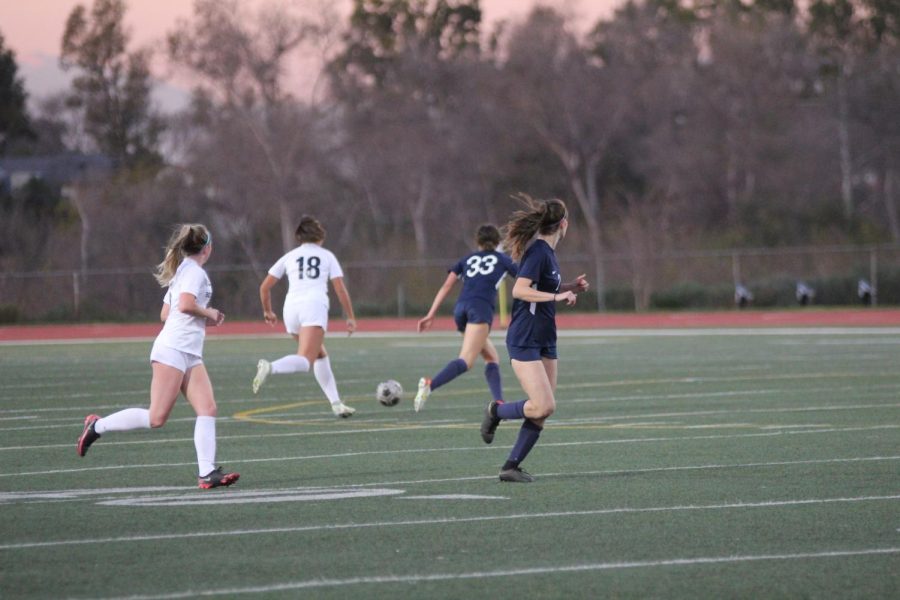The Unequal Distribution of Funds Amongst Team Levels
Varsity girls soccer against Beckman.
February 15, 2022
Being part of a high school sports program goes beyond the physical aspect of playing a sport. One major aspect is funding, which fuels the operational side of a sports team. Although high school sports don’t charge membership fees, many of the teams’ operations rely heavily on school funding and player donations.
Given that players are often asked to donate a certain amount of money regardless of their standing in the program, experience in the sport, or team level, it is reasonable for players to expect to see a portion of those funds go back to their team’s assets. However, the harsh reality is that—after coaches’ salaries, transportation and location fees, and varsity’s portion of the program’s funding are subtracted from the budget—the junior varsity (JV) and frosh/soph levels receive a disproportionately low amount of funding and resources.
“I definitely understand that the highest level teams should be well funded, but I think everyone deserves a fair amount of resources to succeed,” junior Sarah Romito said. “It’s just not fair to see the other girls on JV and frosh try really hard and struggle because they don’t have the resources to build on their skills.”
Romito, who has been a member of the Girls Soccer program for three years, relayed that the JV and frosh teams have faced similar challenges with resources this year. Despite over 50 girls being part of the program, the JV and frosh teams were left with an uneven distribution of players due to injuries within each level. While varsity has still been able to play with subs, JV and frosh/soph have had to borrow players and rotate positions. Romito herself has been stepping in as a goalkeeper instead of her usual midfield position to ensure that the team can play.
In addition to the need for players, it seems that the other teams are also short on equipment. Although funding for equipment mainly comes from player donations to the program, the pandemic has made it more difficult for team members to contribute, especially when there was a lot of uncertainty about how the season would proceed.
“One of the most concerning things is how outdated the equipment and uniforms are for the JV and frosh levels,” Romito said. “Half the time, our soccer balls are deflated by the second half of the game and the uniforms aren’t size inclusive.”
Though soccer has specific needs for training, this concern is universal for many sports that require a lot of team equipment. Teams might require gear in addition to uniforms, which limits the ability of a program to update equipment as frequently as it should be.
“The ideal distribution of funding for high school athletics would be equal across all sports—for boys’ and girls’ sports and for any level—or need-based,” senior Clarisse Woo said. “However, the reality of most programs is that teams that have a bigger audience or are more well-known receive more funding.”
This is true for many of the sports programs that field all three levels of teams. However, not all of the school’s programs deal with such a large resource gap between teams. According to Woo, the Girls Lacrosse program holds many player-led fundraisers throughout the year, which allow every player to contribute.
“Much of the funding within the girls’ lacrosse program at Uni comes from fundraisers or school events that involve clubs,” Woo said. “I’m satisfied with how these funds are distributed within the program, as any player has the opportunity to buy merchandise, and funds go towards transportation, tournaments, and equipment for both [JV and varsity].”
Though the lacrosse program maintains a fair distribution of funds within each team level, it is important to note that the program only fields two teams. This raises the question of whether or not the number of teams changes the balance of funds. On one hand, donation efforts would be more widespread, but on the other hand, it still wouldn’t indicate a fair distribution of resources to the JV and frosh/soph teams relative to varsity.
To further address this concern, one can look to joint programs where funding and resources are shared by the girls and boys teams. Sports like cross country, wrestling, swim, and track and field must divide funds and resources between the girls and boys teams within each level.
“I think [funding and resources] are equal, especially in wrestling because there are always at least two technique coaches, and everyone is on the same mat,” freshman Roshana Akhtari said. “In general, I think funding is mainly focused on uniforms, gear, games, and paying the coaches.”
With joint programs, it is harder to evaluate the distribution of resources, since many athletes within the sport already pay the costs of individual equipment. On top of that, sports with joint programs also have a more flexible roster among teams. Players can compete at different levels depending on their coaches’ preferences, and the boundaries between frosh/soph, JV, and varsity are fluid. It comes down to the amount of time and energy coaches put into each team.
Considering the effect of having more levels of teams, it is also important to examine additional resources that are granted to sports programs. Beyond program funding, teams also receive funding from the District. According to UHS Athletic Director Mr. Shrake, the District strives to provide a baseline experience for all the athletes within IUSD. This means providing funding for safety equipment, coaches, officials, and transportation.
“[Funding] is based on how many levels each sport has. Beyond that, it’s also based on what the district can help with,” Mr Shrake said. “There’s no flags on [the funds] that say that money has to be spent on JV or varsity. It’s at the school’s discretion, after consulting with the head coaches, on how that money should be allocated.”
With the costs of essential sports equipment and the majority of coaches’ salaries, transportation, and officials covered by the district, each program has autonomy when it comes to further enhancing the athletic experience. Though finances vary within each program, the school is still trying to “figure out a fair way to allocate funds,” according to Mr. Shrake.
While varsity remains the top priority of most sports programs, it is important to remember that all athletes deserve an equal amount of recognition for their commitment to their sport. Still, there remains an undeniable difference between the treatment of different level teams, and it is important that coaches, parents, and administrators realize and address the needs of each team.






